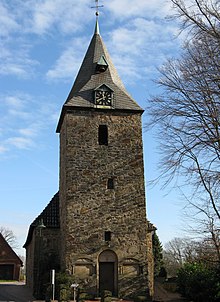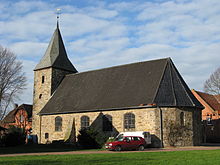Shlisselburg (Petershagen)
|
Key castle
City of Petershagen
|
|
|---|---|
| Coordinates: 52 ° 28 ′ 55 ″ N , 9 ° 4 ′ 13 ″ E | |
| Height : | 31 m above sea level NN |
| Area : | 7.03 km² |
| Residents : | 523 (Oct 1, 2010) |
| Population density : | 74 inhabitants / km² |
| Incorporation : | 1st January 1973 |
| Postal code : | 32469 |
| Area code : | 05761 |
|
Location of Schluesselburg in Petershagen
|
|
Schliisselburg an der Weser is a village in the Weser bend between Minden and Nienburg , which developed around the castle of the Minden bishops at this point. Today it is part of the city of Petershagen .
history
Until the municipal reorganization on January 1, 1973, Schlüsselburg was an independent municipality with a total area of around. 7.03 km² and 648 inhabitants (31 December 1972) and belonged to the Office Windheim to Lahde in Minden . On January 1, 1963, the municipality of Wasserstraße was spun off with 10.48 km² at that time .
Key castle
The Schluesselburg and, as a result, the arable town came into being due to violent border disputes between the Counts of Hoya and the Bishop of Minden. In 1335, Bishop Ludwig von Braunschweig-Lüneburg built the Schlüsselburg on an island in the Weser, and in return the Counts of Hoya secured their territory with the “Feste Haus” in Stolzenau . In the immediate vicinity of the castle, the "Vorburg", the castle men settled . The actual place was laid out according to plan in the second half of the 14th century and its floor plan with the three parallel streets and the narrow, urban development has largely been preserved. Already in 1400 the place received a limited town charter . In addition to the free election of a mayor, councilor and judge, this right also included the privilege of holding markets . By the beginning of the Thirty Years' War , Schlüsselburg had developed into a small town that based its modest "prosperity" mainly on agriculture.
With the Thirty Years War, the looting and the five devastating fire disasters in the period from 1617 to 1711, the place visibly became impoverished. The chronicle reports that the first great conflagration in 1617 completely reduced the place to ashes except for the church, the castle and a town house and bakery. The fire commemoration day, which is celebrated every year on September 4th with a church service , still reminds of this catastrophe .
Scheunenviertel
As early as the beginning of the 17th century, barns outside the actual urban area on the Humke can be identified. The lack of space (due to the close development of the place) and the recurring floods of the Weser and later also the fire disasters probably caused the Schlüsselburgers to store the agricultural equipment, the harvest supplies and the seeds outside the farm.
The Schlüsselburger Scheunenviertel is a "two-aisled" building, the layout of which is designed in such a way that one "ship" was navigable at a time. The half-timbering of the buildings is often still made of oak, some of the compartments still have their original clay filling, and some roof coverings are still made of field fire hollow bricks .
Especially during the 19th century, the buildings were constantly expanded and enlarged due to increasing harvest yields. By removing the inner walls, some barns were adapted to the new economic conditions over time.
The listed ensemble owes its preservation to the fact that most of the buildings were still used for agriculture until the very recent past. T. still be. In the 1970s, some barns threatened to deteriorate. By placing this rural cultural monument of supra-regional importance under protection and through the close cooperation of the owners with the city of Petershagen, the Minden-Lübbecke district , the State Office for Monument Preservation and the Office for Agricultural Regulations , this decay could be prevented. A restoration phase has been initiated in recent years and is almost complete.
Another 26 barns have been preserved in their original two-column half-timbered construction. Together with nine other Scheunenviertel, the Schlüsselburg Scheunenviertel will also be presented to the public as part of the “Regional Scheunenviertel of the Aller-Weser-Hunte Region” project.
Attractions
Buildings
- The Protestant parish church , a small hall building with a polygonal end and west tower, was built in 1585 by Drosten Ludolf von Klencke and the council of the town of Schlüsselburg. In 1864 the tower was raised. The interior is covered by a vaulted wooden ceiling. The furnishings include a winged altar from 1627 with panel paintings by Johann Hopffe, a baptismal font from 1587 and an epitaph for Ludolf von Klencke (1527–88) probably made by the carver Wolff the Younger . The pulpit was created in 1676. There are also several grave slabs from the 16th and 17th centuries in the church.
- The cemetery chapel in the Röhden district was built in 1659. It houses a baroque altar from 1661.
- Shlisselburg Castle (private property) was built in 1335 by Bishop Ludwig von Minden to protect it against the Counts of Hoya. The manor house was completely rebuilt from 1581 to 1585 by Ludolf von Klencke. It is a simple two-story plastered building with triangular gables . A stork's nest has been on the chimney above the north gable for many decades (at least since 1935) .
- The town center is still partly characterized by half-timbered buildings, all of which date from the reconstruction phase after the great fires of 1617 and 1711. However, many have recently been rebuilt, greatly changed by not always successful modernizations, or even demolished. The half-timbered exterior walls were often replaced by brick. The oldest surviving house, Hohe Straße 24 , dates from 1618. Its gate beam is decorated with fan rosettes . The house Vorburg 7 , built in 1686, is provided with a bay.
- Outside the town center is the so-called Scheunenviertel , a collection of 26 half-timbered barns , most of which date from the 18th and 19th centuries. The oldest barn building is number 43 (Blaas). The core of it probably dates back to the 16th century and was rebuilt in the 18th and 19th centuries.
More Attractions
- The nature reserve “Großer Weserbogen - Schlüsseldorf Barrage ” is of international importance; Lookout tower in the southwest in front of the Weser dike and hydroelectric power station
- Eel catchers : river fishermen below the barrage on the Weser
- Cycle route: The Weser cycle route from Hann. Münden to Bremerhaven and the mill route lead through Schlüsselburg.
Culture
The result of the close development, which is atypical for a village, with its heritage-protected half-timbered house ensemble, has developed close neighborly ties, which are reflected today, among other things, in a diverse and lively club life. There is a fishing club, a men's singing club (from 1858), a sailing club and a sports club that work together in the “Schluesselburg cultural community”. This also includes the fire fighting group of the volunteer fire brigade and their music train, the local agricultural association, the hunting association, the "Oldtimer Tractor Friends Mittelweser", the parish with its trombone choir, the senior citizens' club and the Minden Diakonie with its "Menzestift Schlüsselburg" home for the elderly and disabled.
In 2008 the newly founded association "Dat Schünenviertel" became a member of the cultural community. Since September 1997 there is a newsletter of the cultural community, the "Schlüsselburger Info", with monthly publication.
Relation to Shlisselburg in Russia
In Russia there is a place of the same name ( Schluesselburg ). This is near St. Petersburg on the Neva River .
To commemorate the fighting in World War II , a sign with the following inscription was attached to the local war memorial:
SCHLUSSELBURG A / NEVA AND THE
PLACE OF THE SAME NAME A / WESER
MAY BUILD
THE BRIDGE TO
GENERAL UNDERSTANDING AND FOR PEACE.
AND
HONOR TO THE MEMORIAL OF THE FALLEN PEOPLE WHO LEAVED THEIR LIFE
IN THE STORM OF
INF REGTS 424 UNDER COLONEL HARRY HOPPE
IN THE NEVA CITY ON September 8, 1942
traffic
The Schlüsselburg (Weser) train station is on the Nienburg – Minden railway line . It is no longer served, the trains pass without stopping.
See also
Individual evidence
- ↑ Martin Bünermann, Heinz Köstering: The communities and districts after the municipal territorial reform in North Rhine-Westphalia . Deutscher Gemeindeverlag, Cologne 1975, ISBN 3-555-30092-X , p. 118 .
- ↑ Stephanie Reekers: The regional development of the districts and communities of Westphalia 1817-1967 . Aschendorff, Münster Westfalen 1977, ISBN 3-402-05875-8 , p. 280 .
literature
- Bernd Wilhelm Linnemeier: Contributions to the history of Flecken and parish Schluesselburg with the collaboration of Fred Kaspar and Klaus G. Püttmann. Stolzenau 1986.
Web links
- Key castle
- Schlüsselburg in the Westphalian Cultural Atlas









